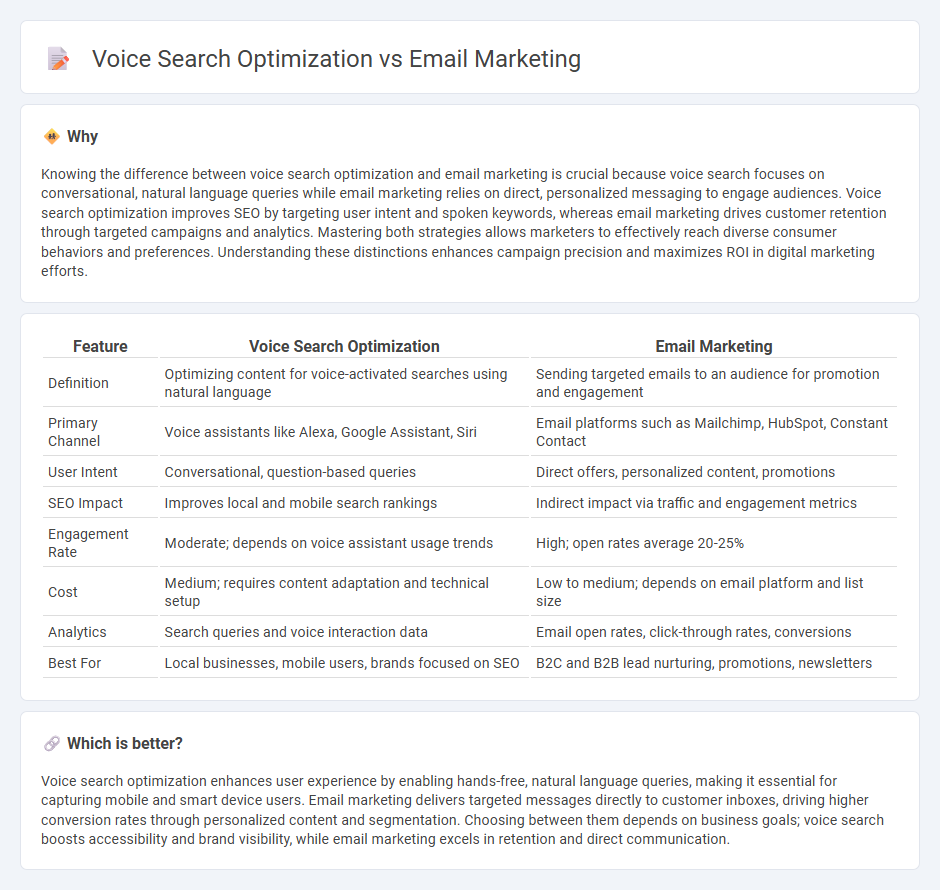
Voice search optimization leverages natural language processing to enhance brand visibility on voice-activated devices, driving higher user engagement through conversational queries. Email marketing remains a powerful channel with targeted campaigns delivering personalized content directly to subscribers, boosting conversions and customer loyalty. Discover the key strategies to integrate both approaches effectively for maximum marketing impact.
Why it is important
Knowing the difference between voice search optimization and email marketing is crucial because voice search focuses on conversational, natural language queries while email marketing relies on direct, personalized messaging to engage audiences. Voice search optimization improves SEO by targeting user intent and spoken keywords, whereas email marketing drives customer retention through targeted campaigns and analytics. Mastering both strategies allows marketers to effectively reach diverse consumer behaviors and preferences. Understanding these distinctions enhances campaign precision and maximizes ROI in digital marketing efforts.
Comparison Table
| Feature | Voice Search Optimization | Email Marketing |
|---|---|---|
| Definition | Optimizing content for voice-activated searches using natural language | Sending targeted emails to an audience for promotion and engagement |
| Primary Channel | Voice assistants like Alexa, Google Assistant, Siri | Email platforms such as Mailchimp, HubSpot, Constant Contact |
| User Intent | Conversational, question-based queries | Direct offers, personalized content, promotions |
| SEO Impact | Improves local and mobile search rankings | Indirect impact via traffic and engagement metrics |
| Engagement Rate | Moderate; depends on voice assistant usage trends | High; open rates average 20-25% |
| Cost | Medium; requires content adaptation and technical setup | Low to medium; depends on email platform and list size |
| Analytics | Search queries and voice interaction data | Email open rates, click-through rates, conversions |
| Best For | Local businesses, mobile users, brands focused on SEO | B2C and B2B lead nurturing, promotions, newsletters |
Which is better?
Voice search optimization enhances user experience by enabling hands-free, natural language queries, making it essential for capturing mobile and smart device users. Email marketing delivers targeted messages directly to customer inboxes, driving higher conversion rates through personalized content and segmentation. Choosing between them depends on business goals; voice search boosts accessibility and brand visibility, while email marketing excels in retention and direct communication.
Connection
Voice search optimization enhances email marketing by targeting conversational keywords that align with how users verbally inquire about products or services. Integrating voice search data helps craft more relevant email content and subject lines, increasing open rates and user engagement. Leveraging voice search insights ensures email campaigns are tailored to the evolving search behaviors of consumers, boosting overall marketing effectiveness.
Key Terms
Open Rate (Email Marketing)
Email marketing relies heavily on crafting compelling subject lines and personalized content to improve open rates, which average around 20-25% across industries. Voice search optimization enhances content discoverability through natural language queries, impacting customer engagement indirectly but not directly tied to email open metrics. Explore effective strategies to boost your email marketing open rates and harness voice search trends for better audience reach.
Keyword Optimization (Voice Search Optimization)
Keyword optimization in voice search focuses on natural language phrases and question-based queries, differing significantly from traditional email marketing keywords which target concise, direct terms. Voice search optimization demands incorporating long-tail keywords that mirror conversational speech patterns, enhancing the chances of capturing voice-driven traffic. Explore how adapting your keyword strategy for voice search can boost engagement and visibility in emerging search trends.
Personalization
Email marketing leverages data-driven personalization to deliver tailored content and offers directly to individual inboxes, increasing engagement and conversion rates. Voice search optimization prioritizes natural language and context to provide users with accurate, personalized responses through voice-activated devices. Explore more to understand how combining these strategies can enhance your marketing impact.
Source and External Links
Email marketing -- a step-by-step guide to getting started - Email marketing involves defining your audience, setting goals, choosing a platform, building and segmenting an email list, creating and testing emails, and measuring results to engage customers effectively and affordably.
Email Marketing: Everything you need to know | Mailchimp - Email marketing types include welcome emails, newsletters, lead nurturing emails, and confirmation emails, each serving a different purpose to engage customers and drive conversions.
What Is Email Marketing? Definition & Tips (2025) | Salesforce US - Successful email marketing relies on personalization, automation, mobile-friendliness, testing, providing value with clear CTAs, and tracking analytics to convert leads and build brand loyalty.
 dowidth.com
dowidth.com